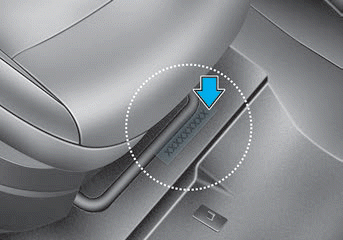Hyundai Venue: Maintenance / Engine Oil
Checking the Engine Oil Level
1. Follow all of the oil manufacturer’s precautions.
2. Be sure the vehicle is on the level ground in P (Park) with the parking brake set. If possible, block the wheels.
3. Turn the engine on and allow the engine to reach normal operating temperature.
4. Turn the engine off and wait about five minutes for the oil to return to the oil pan.
5. Pull the dipstick out, wipe it clean, and re-insert it fully.

6. Pull the dipstick out again and check the level. The level should be between F and L.

7. If it is near or at L, add enough oil to bring the level to F.
Use only the specified engine oil.
NOTICE
To prevent damage to your engine:
- Do not overfill with engine oil. Add oil in small quantities and recheck level to ensure engine is not overfilled.
- Do not spill engine oil when adding or changing engine oil. Use a funnel to help prevent oil from being spilled on engine components. Wipe off spilled oil immediately.
Checking the Engine Oil and Filter
Have engine oil and filter changed by an authorized HYUNDAI dealer according to the Maintenance Schedule at the beginning of this chapter.
WARNING
CALIFORNIA PROPOSITION 65 WARNING
Engine oil contains chemicals known to the State of California to cause cancer, birth defects and reproductive harm. Used engine oil may cause irritation or cancer of the skin if left in contact with the skin for prolonged periods of time. Always protect your skin by washing your hands thoroughly with soap and warm water as soon as possible after handling used oil.
 Explanation of Scheduled Maintenance Items
Explanation of Scheduled Maintenance Items
Engine Oil and Filter
The engine oil and filter should be changed at the intervals specified in the
maintenance schedule. If the vehicle is being driven in severe conditions, more
frequent oil and filter changes are required...
 Engine Coolant
Engine Coolant
The high-pressure cooling system has a reservoir filled with year-round antifreeze
coolant. The reservoir is filled at the factory.
Check the antifreeze protection and coolant level at least once a year, at the
beginning of the winter season and before traveling to a colder climate...
Other information:
Hyundai Venue (QX) (2020-2025) Owners Manual: Forward Collision-Avoidance Assist (FCA) System
Forward Collision-Avoidance Assist (FCA) system is designed to help detect and monitor the vehicle ahead in the roadway through camera recognition to warn the driver that a collision is imminent, and if necessary, apply emergency braking. Forward Collision-Avoidance Assist system helps detect the vehicle ahead in the roadway through camera...
Hyundai Venue (QX) (2020-2025) Service Manual: CVVT (Continuously Variable Valve Timing) System. Description and operation
Description Continuous Variable Valve Timing (CVVT) system advances or retards the valve timing of the intake and exhaust valve in accordance with the ECM control signal which is calculated by the engine speed and load. By controlling CVVT, the valve over-lap or under-lap occurs, which makes better fuel economy and reduces exhaust gases (NOx, HC) and improves engine performance through reduction of pumping loss, internal EGR effect, improvement of combustion stability, improvement of volumetric efficiency, and increase of expansion work...
Categories
- Manuals Home
- 1st Generation Venue Owners Manual
- 1st Generation Venue Service Manual
- Remote start
- Check Tire Pressure
- Rear Combination Light Bulb Replacement
- New on site
- Most important about car
Vehicle Identification Number (vin), Vehicle Certification Label
Vehicle Identification Number (vin)

Frame number

